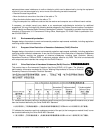
22 Constellation ES Serial ATA Product Manual, Rev. G
3.14 Agency certification
3.14.1 Safety certification
These products are certified to meet the requirements of UL60950-1, CSA60950-1 and EN60950 and so
marked as to the certify agency.
3.14.2 Electromagnetic compatibility
Hard drives that display the CE mark comply with the European Union (EU) requirements specified in the Elec-
tromagnetic Compatibility Directive (2004/108/EC) as put into place 20 July 2007. Testing is performed to the
levels specified by the product standards for Information Technology Equipment (ITE). Emission levels are
defined by EN 55022, Class B and the immunity levels are defined by EN 55024.
Drives are tested in representative end-user systems. Although CE-marked Seagate drives comply with the
directives when used in the test systems, we cannot guarantee that all systems will comply with the directives.
The drive is designed for operation inside a properly designed enclosure, with properly shielded I/O cable (if
necessary) and terminators on all unused I/O ports. Computer manufacturers and system integrators should
confirm EMC compliance and provide CE marking for their products.
Korean RRL
If these drives have the Korean Communications Commission (KCC) logo, they comply with paragraph 1 of
Article 11 of the Electromagnetic Compatibility control Regulation and meet the Electromagnetic Compatibility
(EMC) Framework requirements of the Radio Research Laboratory (RRL) Communications Commission,
Republic of Korea.
These drives have been tested and comply with the Electromagnetic Interference/Electromagnetic
Susceptibility (EMI/EMS) for Class B products. Drives are tested in a representative, end-user system by a
Korean-recognized lab.
• Family name: Constellation ES
• Certificate number: STX-Constell-ES (B)
Australian C-Tick (N176)
If these models have the C-Tick marking, they comply with the Australia/New Zealand Standard AS/NZ
CISPR22 and meet the Electromagnetic Compatibility (EMC) Framework requirements of the Australian
Communication Authority (ACA).
3.14.3 FCC verification
These drives are intended to be contained solely within a personal computer or similar enclosure (not attached
as an external device). As such, each drive is considered to be a subassembly even when it is individually
marketed to the customer. As a subassembly, no Federal Communications Commission verification or
certification of the device is required.
Seagate has tested this device in enclosures as described above to ensure that the total assembly (enclosure,
disc drive, motherboard, power supply, etc.) does comply with the limits for a Class B computing device,
pursuant to Subpart J, Part 15 of the FCC rules. Operation with noncertified assemblies is likely to result in
interference to radio and television reception.
Radio and television interference. This equipment generates and uses radio frequency energy and if not
installed and used in strict accordance with the manufacturer’s instructions, may cause interference to radio
and television reception.
This equipment is designed to provide reasonable protection against such interference in a residential
installation. However, there is no guarantee that interference will not occur in a particular installation. If this


















